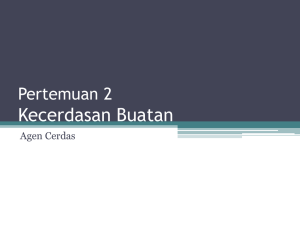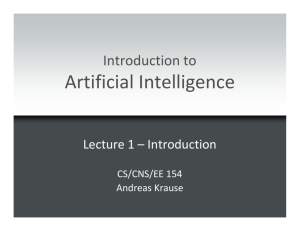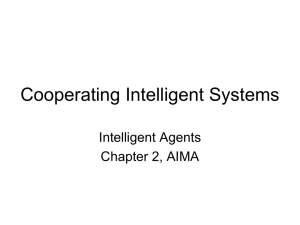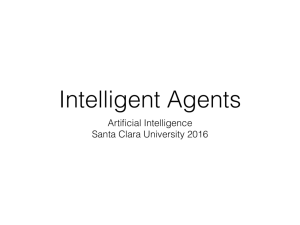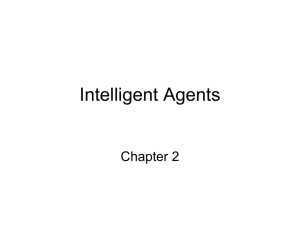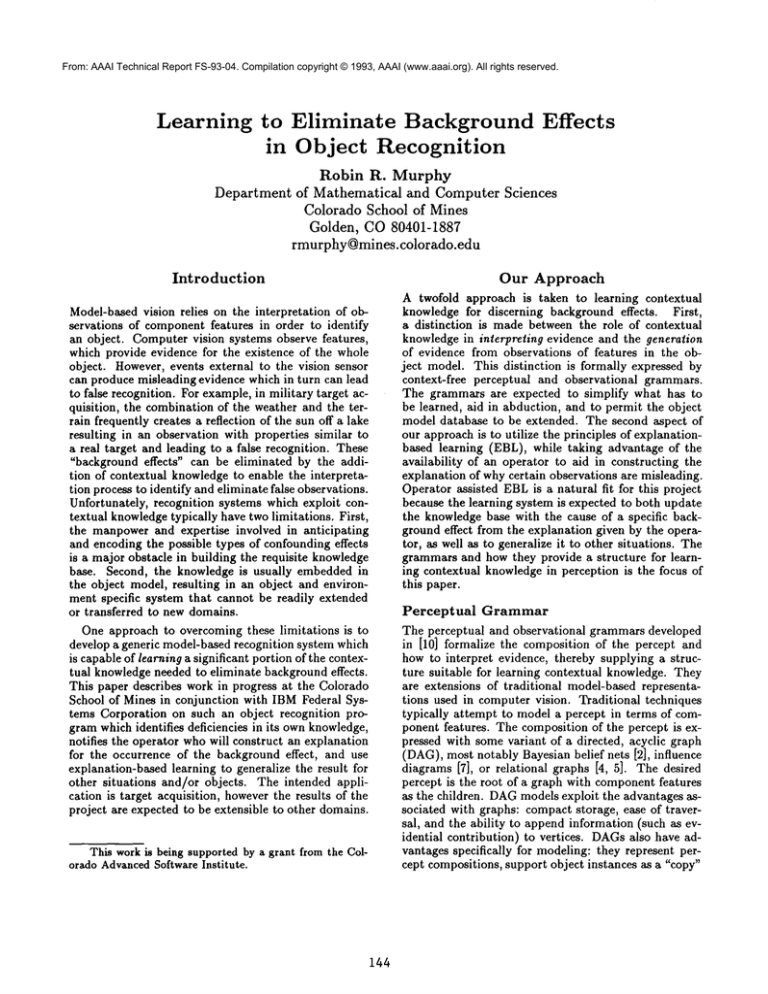
From: AAAI Technical Report FS-93-04. Compilation copyright © 1993, AAAI (www.aaai.org). All rights reserved.
Learning to Eliminate Background Effects
in Object Recognition
Robin R. Murphy
Department of Mathematical and ComputerSciences
Colorado School of Mines
Golden, CO80401-1887
rmurphy@mines.colorado.edu
Introduction
Our Approach
Model-based vision relies on the interpretation of observations of component features in order to identify
an object. Computer vision systems observe features,
which provide evidence for the existence of the whole
object. However, events external to the vision sensor
can produce misleading evidence which in turn can lead
to false recognition. For example, in military target acquisition, the combination of the weather and the terrain frequently creates a reflection of the sun off a lake
resulting in an observation with properties similar to
a real target and leading to a false recognition. These
"background effects" can be eliminated by the addition of contextual knowledgeto enable the interpretation process to identify and eliminate false observations.
Unfortunately, recognition systems which exploit contextual knowledgetypically have two limitations. First,
the manpower and expertise involved in anticipating
and encoding the possible types of confounding effects
is a major obstacle in building the requisite knowledge
base. Second, the knowledge is usually embedded in
the object model, resulting in an object and environment specific system that cannot be readily extended
or transferred to new domains.
One approach to overcoming these limitations is to
develop a generic model-based recognition system which
is capable of learning a significant portion of the contextual knowledgeneeded to eliminate background effects.
This paper describes work in progress at the Colorado
School of Mines in conjunction with IBMFederal Systems Corporation on such an object recognition program which identifies deficiencies in its ownknowledge,
notifies the operator who will construct an explanation
for the occurrence of the background effect, and use
explanation-based learning to generalize the result for
other situations and/or objects. The intended application is target acquisition, however the results of the
project are expected to be extensible to other domains.
This work is being supportedby a grant from the Cob
orado AdvancedSoftware Institute.
144
A twofold approach is taken to learning contextual
knowledge for discerning background effects. First,
a distinction is made between the role of contextual
knowledge in interpreting evidence and the generation
of evidence from observations of features in the object model. This distinction is formally expressed by
context-free perceptual and observational grammars.
The grammars are expected to simplify what has to
be learned, aid in abduction, and to permit the object
model database to be extended. The second aspect of
our approach is to utilize the principles of explanationbased learning (EBL), while taking advantage of the
availability of an operator to aid in constructing the
explanation of why certain observations are misleading.
Operator assisted EBLis a natural fit for this project
because the learning system is expected to both update
the knowledge base with the cause of a specific background effect from the explanation given by the operator, as well as to generalize it to other situations. The
grammars and how they provide a structure for learning contextual knowledgein perception is the focus of
this paper.
Perceptual
Grammar
The perceptual and observational grammars developed
in [10] formalize the composition of the percept and
how to interpret evidence, thereby supplying a structure suitable for learning contextual knowledge. They
are extensions of traditional model-based representations used in computer vision. Traditional techniques
typically attempt to model a percept in terms of component features. The composition of the percept is expressed with some variant of a directed, acyclic graph
(DAG),most notably Bayesian belief nets [2], influence
diagrams [7], or relational graphs [4, 5]. The desired
percept is the root of a graph with component features
as the children. DAGmodels exploit the advantages associated with graphs: compact storage, ease of traversal, and the ability to append information (such as evidential contribution) to vertices. DAGsalso have advantages specifically for modeling: they represent percept compositions, support object instances as a "copy"
p~- 8p
+
p ::~ percept.connectlve
d ::----
(component)
::ffi
Observational
d d
de*cription..connective
+
(cornponent)(cornponent)
Gp must be supplemented because it suffers from the
same difficulties
as traditional DAGbased methods in
representing the transformation of evidence for features
in a model to evidence for a percept. DAG-basedtechniques such as [2, 7] attempt to embed the evidential
contribution of a feature to the overall belief in a percept directly at each feature node in the DAG.This
is challenging because the evidential contribution of a
feature may depend on the context. The description of
the sensing objective affects the belief in the percept
because some models are "better" than others. A description of a MY COFFEE CUP as a set of 3D surfaces
maybe sufficient for recognition but a description using 2D features may be more distinctive. The choice of
sensors and algorithms will also influence the belief in
the percept. For example, the Sobel and Marr-Hildreth
operators are both edge detectors but give different results when applied to the same image. The surrounding
environment also plays an important role in determining the evidential contribution of a feature. Consider
recognizing MY COFFEE CUP, which is the only cup in
the office that particular shade of blue with a cracked
handle. There may be many coffee cups the same shape
and size in myoffice. Since it knownto be the only cup
that color, blue contributes more evidence that it is MY
COFFEE CUP than other features in the description such
as size, shape, and cracked handle. On the other hand
if MYCOFFEECUPis at home where there are other
cups the same color blue, the evidential contribution of
the color diminishes while the contribution of observing
the cracked handle increases.
Traditional DAGsattempt to accommodate the impact of the perceptual context on evidence by adding
new nodes and links to the model to reflect the probabilistic conditioning of the evidence on the evidence
for the current context. Unfortunately this has many
undesirable side-effects. More nodes clutter the model
and add computational complexity to the evaluating
the graph. Also, it is impractical to determine the conditioning effects in advance and generate the requisite
probability functions. More relevant for this paper is
that attempting to insert context knowledgeat the feature level complicates learning because it merges the
contributions of observation and context for recognition, obscuring the source of any errors in perception.
The shortcomings in the perceptual grammar were
addressed in [10] which developed an observational
grammarisomorphic to the perceptual grammar but capable of evidential management and propagation. The
observational
grammar produces a DAGwhose structure corresponds to the composition of the percept
given by the Gp by limiting the introduction of contextual influences.
The observational grammar Go considers context as
a mechanismfor interpreting: given that it is knownMY
COFFEE CUP is the only blue one in the office and that
the region of interest is the office, blue counts more for
(feoture)~d]p
(feature)::ffi
primitive
(extended)
(relational)
(coTnpound)
(functional)
[(extended)[(relational)
::----
[(compound)
extending.connective
::m rel6tionsl_connective
::~
compound.connective
::m functlon&l_connective
[(functional)
(component)
( co~qponent ) (eornponent
Grammar
+
(component)
+
(component)(cornponent)
Figure 1: Production rules for Gp.
of a DAGfor a class of objects, and allow links to viewpoints.
Unfortunately, current instantiations of DAGsare ad
hoc and have other disadvantages.
The DAGmodels
are rigid; they are either developed for a single perceptual task ignoring the need to model different uses (for
example, a modelsufficient for recognizing a coffee cup
maynot be sufficient for grasping the cup) or monolithic
ignoring the role of selective perception. The models
tend to be committed to a particular set of primitives
(such as generalized cylinders). Manymodeling techniques favor strictly geometric features and restrict relationships to IS-A and PART-OFhierarchies, excluding
other types of features (e.g., qualitative, functional).
The graph representation was extended and encapsulated into a context-free perceptual grammarin [10],
leading to a DAGcapable of supporting a broader feature palette, selective perception, and sensor fusion.
The underlying concept of the perceptual grammar, Gp,
is that a percept can be expressed in terms of descriptions. A description is a collection of features which
are necessary and sufficient for the accomplishment of
a particular sensing objective; therefore each description is selectively perceptive. A feature is not limited
to a particular type; the grammarrecognizes primitives,
such as edges and regions; relational features, such as
bigger, adjacency, distance, compactness, above, and
beside [1]; compoundfeatures, including grouping by
perceptual organization techniques [8]; and functional
features, for example "sitability" [12]. The family of
descriptions of an object for all sensing objectives is
called the percept model. More than one description
can he used to represent the percept for a particular
sensing objective.
The grammar is given by Gp = (Np,Tp, Pp,sp)
where: Np, is the set of nonterminal elements or features; Tp, the set of terminal elements, are the connectives (or sensing algorithms), and the basic feature,
primitive; P?, are the production rules; and sp, the start
element, sp E Np, is the percept: p. The production
rules, Pp, are given in extended Backus-Naur Form using prefix notation in Figure 1.
145
(percept) d, o
(percept) ::ms percept.lnterpret&tion(deseriptiori)
(description) ::ffi
de.cription +
lnterpretation(evidential.f
+
(description)
eature)(evidential.f
eature)
(evidential.feature)
::z
feature.interpretation feature.observed testure.expected
Figure 2: Production rules for Go.
recognition in that situation. Interpretation of the evidence from the observation of a feature can be viewed as
different frames of discernment (i.e., frames of evidential reference). The grammardefines three such frames:
¯ Feature: how much belief there is for a feature in
the model. The belief in the expected feature given
the physical operating characteristics of the particular sensor and algorithm being used to observed it
is computed for each feature according to an feature_interpretationfunction.
¯ Description: how the belief in each feature is transformed into belief for a description of the percept,
The role of each feature in the description may be
different from its role in the composition of the
percept (e.g., blue may count more). The description_interpretation function factors in the different evidential contributions of each feature.
¯ Percept: how the belief in a description translates
into belief for the percept and its sensing objective. Since some descriptions offer more evidence
than others, the belief for the description may need
to be weighted. This is done through a description_interpretation function.
Essentially the feature_interpretation functions compute how well what is observed matches the expectations set forth by the model, while the description_interpretation and percept_interpretation functions
account for the context. It should be noted that the
observational grammaris independent of evidential updating technique; the interpretation functions can be
implemented with Bayesian updating using causal matrices as per [11] or by enlargement and refinement of
frames of discernment with Dempster-Shafer theory as
discussed in [9].
The resulting grammar, Go = (No, To, Po, So), can be
expressed as: No, is the set of nonterminal elements, or
types of evidence; To, is the set of terminal elements,
or interpretation functions and the feature_observed and
feature_expected; Po are the production rules; and So is
the start element, So E No: percept observation. The
production rules, Po, are given in extended BackusNaur Form using prefix notation in Figure 2.
Advantages
for Learning
Using Up to model a percept has all the advantages previously ascribed to DAGrepresentations in computer
146
vision, plus more. It can support any type of feature
through connectives which correspond to sensing algorithms. The grammar is recursive, allowing complex
percepts to be constructed from other percepts. Each
description is a de facto modelof the percept for a sensing objective, therefore it is inherently supports selective perception.
The dichotomy of the representation into composition and interpretation
by Go is expected to be advantageous for learning how to modify the evidential
contributions of sensors based on context. Learning
background effects should be simplified because only
the interpretation functions will be operated on, not
the percept models, permitting straightforward credit
assignment.
Howthe grammars and their associated DAGsare actually implemented will also play an important role in
automating learning of contextual effects. The implementation is expected to follow [10] where the percept
model DAGconsists of frames (feature nodes) linked
by pointers (edges). The description and percept interpretation functions are a set of rules attached to the
percept modelitself. Anexecutable sensing plan is built
by examining the percept model DAGand then selecting the appropriate description(s) sub-trees to meet the
sensing objectives for the projected environmental conditions and sensor availability. The selected description
is itself a DAG.The sensor and sensing algorithms are
chosen and their sensing procedures and associated feature interpretation functions are placed in slots at the
feature nodes in the DAG.The DAGnow satisfies Go.
The sensing plan is executed by a depth-first evaluation
of the DAG.
The frame implementation for the model and sensing
plan makes it easy to examine interpretation functions,
change them, and add more. Also, procedures for using
active sensing to disambiguate contextual effects can be
attached to the frames. Frames are expected to contain
slots with the justification for rules which can be examined by the operator and learning system in order
to construct explanations. Additional structures will
be needed for linking features, sensors, and conditions
so that a learning system can generalize the impact of
background effects to other percepts and sensors.
EBL
The grammatical representation
and supporting data
structures described above should enhance learning of
contextual knowledge about perception. Operator assisted explanation-based learning was chosen as the
learning technique because the data fusion system is
expected to both update the knowledge base with the
cause of a specific background effect from the explanation given by the operator, as well aa to generalize it to
other situations.
The major issues in creating an effective explanationbased learning system for eliminating background effects are: Howdoes the system operationalize the oper-
ator’s explanation into an internal representation? The
system must be able to transfer the operator’s understanding into whatever internal representation is used
by the evidential reasoning component. Although a
natural language interface is outside of the scope of
this project, the choice of interface should not burden
the operator with understanding the internal representation. Howdoes the system insure that a new explanation will not introduce errors in other parts of the
knowledge base? The representation must support discerning the impact of an explanation and ask operator
for a further clarification if needed. 1low does the operator and system communicate? Given that the operator
should be shielded from having to know the internal
workings of the fusion system, how can the operator
communicate the explanation? Likewise how does the
system express the side effects that will be introduced
by an inadequate or ambiguous explanation?
References
[1] Ballard, D. H., and Brown, C. M., Computer Vision, Prentice-Hall, EnglewoodCliffs, N J, 1982.
[2] Binford, T.O., Levitt, T.S., and Mann, W.B.,
"Bayesian Inference in Model-Based Machine Vision", Uncertainty in Artificial Intelligence 3, L.N.
Kanal, T.S. Levitt, and J.F. Lemmered., Elsevier
Science Publishers, 1989, pp. 73-95.
[3] Donald, B., and Jennings, J., "Perceptual, Limits, Perceptual Equivalence Classes, and a Robot’s
Sensori-Computational Capabilities", Proceedings
IEEE/RSJ International Conference on Intelligent
Robots and Systems, Osaka, Japan, 1991.
[4] Faugeras, O.D., and Hebert, M., "The Representation, Recognition, and Locating of 3-D Objects",
International Journal of Robotics Research, vol. 5,
no. 3, Fall 1986, pp. 27-52.
[5] Flynn, J.P. and Jain, A.K., "CAD-Based Computer Vision: From CADModels to Relational
Graphs", IEEE Transactions on Pattern Analysis
and MachineIntelligence, vol. 13, no. 2, Feb., 1991,
pp. 114-132.
[6] Henderson, T. and Shilcrat, E., "Logical Sensor
Systems", Journal of Robotic Systems, vol. 1, no.
2, 1984, pp. 169-193.
[7] Levitt, T.S., Agosta, J.M., and Binford, T.O.,
"Model-Based Influence Diagrams for Machine Vision", Uncertainty in Artificial Intelligence 5, M.
Henrion, R.D. Shatter, L.N. Kanal, and J.F. Lemmet, ed., Elsevier Science Publishers, B.V., 1990,
pp. 371-388.
[8] Lowe, D.G., Perceptual Organization and Visual
Recognition, Kluwer, Boston, MA, 1985.
of Dempster[9] Murphy, R.R., "An Application
Shafer Theory to a Novel Control Scheme for Sensor Fusion", SPIE Stochastic Methods in Signal
Processing, Image Processing, and Computer Vision, San Diego, CA, July 21-26, 1991.
[10] Murphy, R.R., "An Architecture for Intelligent
Robotic Sensor Fusion", PhD thesis, Technical
Report #GIT-ICS-92/42, College of Computing,
Georgia Institute
of Technology, Atlanta, GA,
30332-0280.
[11] Pearl, J., Probabilistic Reasoning in Intelligent
Systems: Networks of Plausible Inference, Morgan
Kaufmann Publishers, San Mateo, CA, 1988.
[12] Stark, L. and Bowyer, K., "Achieving Generalized
Object Recognition Through Reasoning About Association of Function to Structure", IEEE Trans.
actions on Pattern Analysis and Machine Intelligence, vol. 13, no. 10., Oct., 1991, pp. 1097-1104.
Summary
Learning the role of contextual knowledgein interpreting perceptual information is necessary for eliminating
false recognition. Work in progress on a system for
learning to eliminate background effects in target acquisition using contextual knowledgeis currently concentrating on the appropriate modeling of the percept
and related knowledge. The proposed DAGrepresentation is expected to be extensible to other applications of
learning in computer vision. Future work will concentrate on building operator assisted explanation-based
learning mechanisms to act on these knowledge representations.
The DAGis formally expressed by two context-free
grammars. The perceptual grammar Gp is concerned
with modeling the percept in terms of abstract descriptions and features. The descriptions and features act
as building blocks for sensing plans and are similar to
logical sensors [6] and equivalence classes [3]. The observational grammarGo expresses the evidential contribution of sensor observations of the percept, essentially
overlaying the structure given by Gp. It incorporates
physical models of imprecision and contextual knowledge as three interpretation functions, rather than as
conditional probabilities. Learning will impact the interpretations functions, not the object description and
features.
Acknowledgments
This research is being conducted under a CASITechnology Transfer grant in conjunction with IBMFederal
Systems Corporation. CASI is sponsored in part by
the Colorado Advanced Technology Institute
(CATI),
an agency of the State of Colorado. CATI promotes
advanced technology education and research at universities in Colorado for the purpose of economicdevelopment.
147

